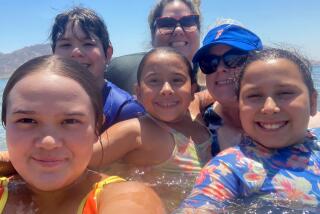Families Try to See Light Left Behind by 2 Victims
- Share via
LAGUNA NIGUEL — On a cool September morning last year, the Grubb and Ciskowski families received telephone calls that would shatter their lives.
Jake Grubb was watching TV at home in Laguna Niguel when the San Diego coroner’s office called. A hundred miles away, John and Connie Ciskowski were vacationing in Borrego Springs when John’s father notified them.
The parents’ children, Graham J. Grubb and Amanda J. Ciskowski, had been run over and killed as they camped out at San Onofre State Park. Both were 18.
Police reported that the driver of a Ford Mustang plowed through the young couple’s tent on the beach, dragging it 35 feet. He then abandoned his car, and later he and his passenger hired a cab to return home, police allege.
The alleged driver, Douglas J. Freels, 24, a Bellflower warehouseman, is scheduled to go on trial Feb. 26 on charges of felony drunk driving, hit-and-run driving and two counts of gross vehicular manslaughter.
The trial is going to be an emotional one for the two families, who have been trying to piece their lives back together, said Mary Mayer-Grubb, Graham Grubb’s stepmother.
Connie Ciskowski said she remembers clearly the evening before her daughter was killed. The night sky in Borrego Springs was flashing with stars.
“The night was so beautiful. I didn’t want it to end,” she said.
The next day, Ciskowski said, the beauty of the night was gone. And now, starry nights do not seem quite the same.
The victims began dating just three months before their deaths. Both shy and quiet, they met at a birthday party and were instantly drawn to each other. He lived in Laguna Niguel and she in San Diego, but they shared weekends together.
After the tragedy, the couples--who both have one other child, both daughters--decided that the victims should remain together. While half of Graham Grubb’s ashes were scattered at sea, the rest were buried with Amanda Ciskowski’s remains. The Ciskowskis also had his name engraved on her tombstone, which reads, “Our Beloved Angels.”
While the families wait for the trial to begin, they have tried to heal.
For the Ciskowskis, healing means literally pounding out their grief. The couple are building a three-bedroom house in Borrego Springs. They have finished the foundation and are putting up the walls.
Amanda Ciskowski, who had graduated from Coronado High School, was the youngest of their two daughters. She had been saving money for college from her job at a retirement home.
“We’re taking each day at a time,” Connie Ciskowski said. “We wake up when it’s light and work all day till we can’t see anymore. And we start all over again.”
For the Grubbs, healing means sharing stories about their son, who loved the outdoors and the ocean. He and his family were among the first members of Surfrider Foundation, an organization devoted to conserving the shoreline.
His friends have kept in touch. They even made a memorial video for the family.
“The kids have been so good to us,” Mayer-Grubb said. “They come by and call. It’s people our age who are finding it difficult to talk to us. I guess it’s because they’re thinking, ‘It could have been my kid.’
“But the kids talk to us and make us think good things about Graham and Amanda.”
There have been good days too, such as watching the movie “Dances With Wolves,” which was released two months after the deaths.
“We both agreed that Graham would have loved the movie, and it was wonderful that we were able to say that and feel as if he was with us,” Mayer-Grubb said.
But there have also been difficult times, such as trying to clean up his room. His camping map still hangs on the bedroom door.
Like other teen-agers caught between adolescence and adulthood, Graham had decorated his room with objects showing both his youth and maturity. There are surf posters on the walls, as well as a prized Ansel Adams photograph and his Dana Hills High School diploma.
Every once in a while, when Jake Grubb arrives home at night, he sees his son’s room and remembers how he had a habit of leaving the light on.
“He was always in and out of that room, and he always forgot to turn the light off,” he said. “But when he was in that room, I knew he was always doing something.
“In a way, he was that light, and he was constantly shining.”
More to Read
Sign up for Essential California
The most important California stories and recommendations in your inbox every morning.
You may occasionally receive promotional content from the Los Angeles Times.













